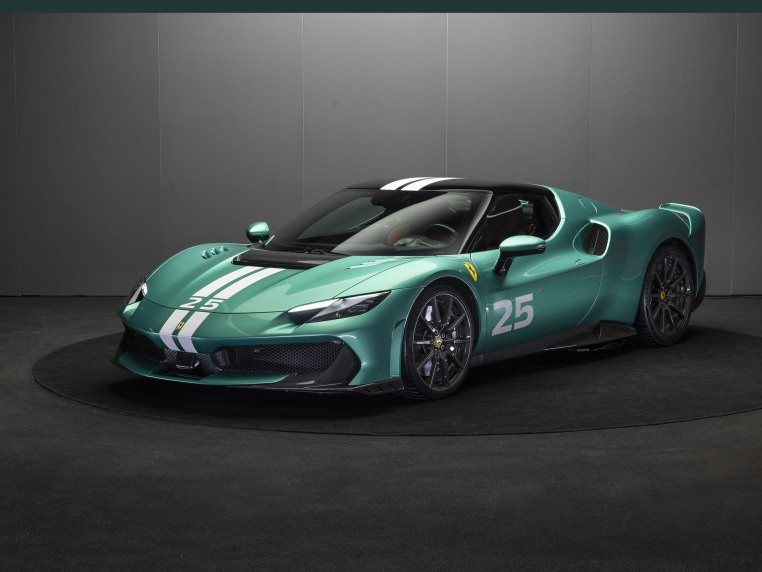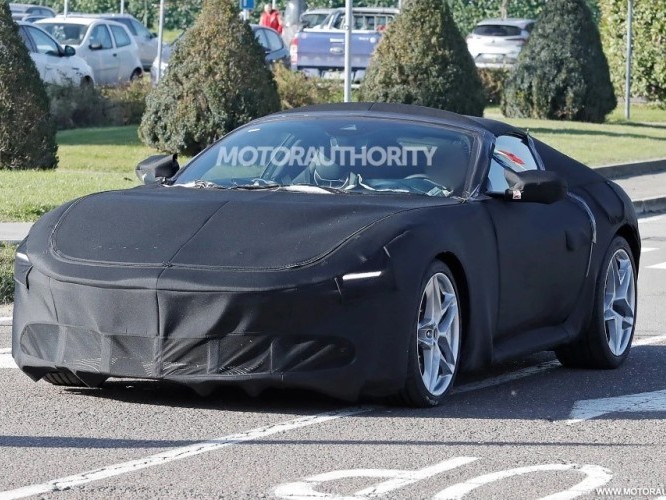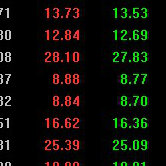Q
What's the price of Ferrari 296?
The Ferrari 296 has different models with varying prices. Among them, the 2022 Ferrari 296 GTB V6 is priced at RM 1,228,000, while the 2022 Ferrari 296 GTS V6 costs RM 1,448,000. Both models are supercars featuring a gasoline-electric hybrid system with powerful performance. The official 0-100km/h acceleration time is just 2.9 seconds, and their top speed reaches 330km/h. Their design emphasizes aerodynamics, showing a sleek and dynamic exterior. Despite the two-seater cabin layout, the interior adopts cutting-edge technology, including advanced driver assistance and multimedia systems. In terms of fuel efficiency, its official combined fuel consumption is 6.6L/100km, with a pure-electric range of up to 25km.
Special Disclaimer: This content is published by users and does not represent the views or position of PCauto.
Related Q&A
Q
Does Ferrari 296 have a manual or automatic transmission?
The Ferrari 296 is equipped with a wet dual-clutch transmission (DCT), an automatic transmission technology. This transmission enables rapid and smooth gear shifts, providing the vehicle with enhanced acceleration performance and comfortable driving experience. The dual-clutch transmission features two clutches: one handles odd-numbered gears (1st, 3rd, 5th, etc.), while the other manages even-numbered gears (2nd, 4th, 6th, etc.). Through the coordinated operation of these two clutches, its shift times are significantly reduced while maintaining continuous power output during gear changes, which not only improves the vehicle's acceleration times but also reduces fuel consumption to some extent. Additionally, certain DCT transmissions offer manual shift modes, allowing drivers who prefer to control shift timing to enjoy the engagement of manual driving. The Ferrari 296 combines the advantages of both automatic and manual transmissions.
Q
What are the differences between Ferrari F8 and 296?
There are several differences between the Ferrari F8 and the 296. In terms of powertrain, the F8 is equipped with a 3.9T V8 twin-turbo engine delivering a maximum power output of 530 kW, while the 296 features a plug-in hybrid system combining a new 120° V6 engine with an electric motor, achieving a combined system output of 610.294 kW. Regarding exhaust sound, the 296 GTB has been specially tuned to produce a more pronounced note compared to the F8.
In exterior, the F8 measures 4611 mm in length, 1979 mm in width, and 1206 mm in height with a 2650 mm wheelbase, whereas the 296 GTB is 4565 mm long, 1958 mm wide, and 1187 mm tall with a 2600 mm wheelbase. Both models shows distinct styles and details.
For the interior, the 296 incorporates certain design elements from the SF90, including the touch-sensitive ignition switch, giving it a more technologically advanced feel similar to the F8.
In price, the F8 is priced at RM 3.057 million, while the 296 GTB is priced at RM 1,228,000 and the 296 GTS at RM 1,448,000.
In summary, each model has its own advantages: the F8 embodies the allure of traditional combustion power, while the 296 showcases Ferrari's pioneering advancements in hybrid technology.
Q
Is Ferrari 296 electric?
The Ferrari 296 is a plug-in hybrid vehicle, not a pure electric vehicle. Its fuel type is Petrol Hybrid (HEV, MHEV), and it is equipped with an internal combustion engine and an electric motor. Taking the 2022 model as an example, the engine delivers a maximum horsepower of 663 PS, while the electric motor produces 166 PS, resulting in a combined system output of 830 PS. The official all-electric range is 25 km. It utilizes a ternary lithium-ion battery with a capacity of 7.45 kWh and an energy consumption rate of 14 kWh/100 km. This hybrid configuration allows the Ferrari 296 to accommodate short-distance travel in pure electric mode, reducing emissions and fuel consumption, while the coordinated operation of the engine and electric motor provides supercar-level performance when needed. The vehicle achieves a top speed of 330 km/h, with an official 0-100 km/h acceleration time of just 2.9 seconds.
Q
What's the design of Ferrari 296?
The Ferrari 296 draws inspiration from multiple aspects. Its design DNA pays homage to the legendary 1963 250 LM, a Le Mans prototype racer, with the 296 GTS specifically engineered to be similar to the 296 GTB's aerodynamic profile and downforce characteristics when the roof is closed. Moreover, it also draw inspiration from the 250 LM. The overall styling retains elements from the simplicity and functional features of 1960s sports cars, featuring sculpted body lines, a "no B-pillar" design, unique fender and intake combinations, and a truncated tail. The cockpit design of the 296 GTB follows the SF90 Stradale's approach, adopting a fully digital interface that enhances its sporty and luxurious feel. This blend of historical and modern elements not only pays homage to Ferrari's heritage but also aligns the 296 with contemporary automotive advancements, delivering a unique and exhilarating driving experience.
Q
How fast is Ferrari 296?
Ferrari 296 can achieve an impressive top speed. Both the 2022 Ferrari 296 GTB V6 and 296 GTS V6 have a maximum speed of 330 km/h. This remarkable speed is accomplished through a powerful combination of components. They are equipped with a petrol-hybrid system where the engine and electric motor work together. The engine is a turbocharged V6 with substantial horsepower, while the electric motor provides additional power. The advanced transmission and drivetrain also play crucial roles in enabling the vehicle to reach such high speeds. Additionally, the aerodynamic design of the Ferrari 296 helps reduce drag coefficient and enhances stability at high velocities. Moreover, the 296 GTB and GTS can accelerate from 0 to 100 km/h in just 2.9 seconds, delivering rapid bursts of speed. In pure electric mode, they can also reach a top speed of 135 km/h with a pure electric range of 25 km.
Q
What's the base price of Ferrari 296?
The Ferrari 296 has different models, and their base prices also vary. Among them, the price of the 2022 Ferrari 296 GTB V6 is RM 1,228,000, and the price of the 2022 Ferrari 296 GTS V6 is RM 1,448,000. The Ferrari 296 belongs to the supercar category, with extremely powerful performance. It uses a Petrol Hybrid (HEV, MHEV) fuel type, combining the advantages of a fuel engine and an electric motor. Its official 0-100km/h acceleration takes only 2.9 seconds, and the top speed can reach 330km/h. In addition, the vehicle's configurations like suspension and braking are also outstanding. The front suspension is a double-wishbone independent, and both the front and rear brakes are ventilated disc brakes, paired with an electronic parking brake, ensuring excellent handling and safety.
Q
Is the 296 a supercar?
Yes, the 296 is indeed a supercar. In terms of performance, the 296 GTB is equipped with a new 120° V6 turbocharged engine producing 663 horsepower, combined with an electric motor delivering up to 166 horsepower, resulting in a total powertrain output of 830 horsepower. It achieves a top speed of 330 km/h and accelerates from 0-100 km/h in just 2.9 seconds according to official figures, demonstrating robust power delivery and quick acceleration.
In design, the 296 incorporates typical aerodynamic features of supercars, such as the signature "tea-tray" front spoiler that generates significant downforce. Its compact body shape and short 2,600mm wheelbase enhance agility and handling. These design elements not only ensure a striking appearance but also optimize performance.
Furthermore, the 296's price positions it firmly within the supercar segment, with the 296 GTB priced at RM1,228,000 and the 296 GTS at RM1,448,000. Considering all these factors together, the 296 undoubtedly qualifies as a true supercar.
Q
What are the differences between Ferrari 296 and Turbo S?
The Ferrari 296 is available in models such as the GTB and GTS, which differ from the Turbo S in multiple aspects. In terms of powertrain, the Ferrari 296 utilizes a petrol hybrid system (HEV/MHEV). For instance, the 296 GTB is equipped with a 3.0L V6 twin-turbocharged gasoline engine paired with a rear electric motor, delivering a combined system output of 830 horsepower. Its official 0-100 km/h acceleration time is 2.9 seconds. If the Turbo S refers to the Porsche 911 Turbo S, it is powered by a 4L twin-turbocharged V8 engine, with specific performance figures differing from the 296.
Regarding exterior design, the 296 GTB features distinctive elements such as its signature "tea-tray" front spoiler and innovative rear style. Different brands and models exhibit their own unique design languages, with variations in lines, proportions, and overall aesthetics.
Inside the cabin, the Ferrari 296 blends Italian flair with cutting-edge digital technology, while the Turbo S interior reflects Porsche's characteristic design philosophy. The two differ in material choices, layout, and human-machine interface design.
For price, the 296 GTB is priced at RM1,228,000 and the 296 GTS at RM1,448,000, whereas the price of Turbo S varies depending on specific model configurations and other factors.
Q
What are the differences between 296 and SF90?
Both the 296 and SF90 are exceptional sports cars under the Ferrari brand, but they differ in multiple aspects. In terms of price, the 296 starts at RM 1,228,000 (296 GTB) and RM 1,448,000 (296 GTS), while the SF90 has a higher manufacturer's suggested retail price. Regarding body dimensions, the 296 GTB measures 4565mm in length, 1958mm in width, and 1187mm in height, with a wheelbase of 2600mm. The SF90, on the other hand, measures 4704mm in length, 1973mm in width, and 1191mm in height, with a wheelbase of 2649mm, making it larger.
Their drivetrain configurations also differ: the 296 GTB is rear-wheel drive, with both the engine and electric motor positioned on the rear axle, whereas the SF90 is an all-wheel-drive vehicle, featuring two motors on the front axle that independently power the front wheels.
In terms of powertrain, the 296 is equipped with a 2.9L twin-turbocharged V6 engine paired with a rear-axle electric motor, adopting a plug-in hybrid system with a maximum output of 830 horsepower. The SF90, meanwhile, features a 4.0L turbocharged engine delivering 780 PS and 800 N·m of torque, and its overall system performance also varies.
These differences allow consumers to make a choice based on their individual needs and preferences.
Q
Is Ferrari 296 an entry-level model?
The Ferrari 296 is not an entry-level model. In terms of price, its selling price ranges from RM 1,228,000 to RM 1,448,000, far exceeding the price range of ordinary entry-level vehicles. In terms of performance, it belongs to the supercar category, featuring a powerful powertrain with a maximum engine output of 663PS, an electric motor delivering 166PS, and a combined system output of 830PS. The official 0-100km/h acceleration time is just 2.9 seconds, with a top speed of 330km/h—performance unattainable by entry-level vehicles. Additionally, it incorporates advanced high-end configurations such as a gasoline-electric hybrid system, all-wheel drive, double-wishbone independent suspension, and ventilated disc brakes. These features collectively demonstrate that the Ferrari 296 is a premium model designed for consumers seeking exceptional performance and driving dynamics, not an entry-level product.
Popular Cars
Model Year
Car Compare
Car Photo
Latest Q&A
Q
How much does it cost to buy a 2024 Tesla Model 3?
The 2024 Tesla Model 3 starts at around RM 175,000, but the final price depends on your chosen configuration and add-ons. Opt for the Long Range or Performance version, and you’re looking at a higher tag.
As Tesla’s entry-level model, it packs cutting-edge EV tech, including 500+ km of range on a single charge and standard Autopilot for both daily commutes and road trips. Just keep in mind extra costs like insurance, registration, and potential home charger installation.
Tesla’s Supercharger network is expanding locally, with solid coverage in major cities, making charging hassle-free. Maintenance costs? Typically lower than gas cars—no oil changes, fewer moving parts—so long-term savings add up.
If you’re after more thrills, the Performance variant hits 0-100 km/h in roughly 3 seconds. Plus, government EV tax perks help soften the upfront cost.
Q
How reliable is the 2024 Model 3?
The 2024 Model 3 delivers solid reliability, thanks to Tesla’s continuous software updates and hardware refinements. Key areas like the battery management system and Autopilot have seen multiple optimizations, leading to a noticeable drop in failure rates.
This model features a stiffer body structure and an improved suspension setup, offering a smoother ride. Upgraded interior materials also help reduce cabin rattles—a common gripe with earlier builds.
EV maintenance costs remain low (no oil changes, etc.), though it’s wise to periodically check battery health and charging components for long-term performance. For shoppers eyeing EVs, charging infrastructure and home charging options matter—thankfully, public chargers are expanding fast, making daily use more convenient.
If you frequently road-trip, planning charging stops ahead helps. While the range easily handles daily drives, a little route prep goes a long way in maximizing the experience.
Q
What is the battery range of the Tesla Model 3 2025?
The battery range of Tesla Model 3 2025 is expected to be optimized based on existing models, and specific data needs to be released officially. However, referring to the EPA range of the 2024 rear wheel drive version, which is about 438 kilometers, and the high-performance version, which is about 513 kilometers, the 2025 model may further improve, especially in terms of battery technology or energy efficiency management. For electric vehicles, the range is greatly affected by driving habits, road conditions, and climate. Air conditioning may slightly reduce the range in hot weather, but the battery thermal management system can usually maintain stable performance. In terms of charging, Model 3 supports super fast charging, which can replenish about 250 kilometers of range in about 15 minutes, while home charging stations require 6-8 hours to fully charge. Daily commuting or long-distance travel are practical enough, it is recommended to follow Tesla's official website or local showroom for the latest information.
Q
Is the 2024 Model 3 worth the price?
The 2024 Model 3 strikes an impressive balance between price and performance. Its upgraded range, more refined interior, and enhanced autonomous driving features genuinely boost its competitiveness—especially for tech-savvy, eco-conscious buyers.
Tesla optimized the battery efficiency this time around, making it suitable for both daily commutes and longer trips, while the handling stays true to the brand’s signature responsiveness. If your budget allows and you’re open to EVs, this one’s worth considering—though a test drive is wise to see if it matches your driving style.
That said, local charging access matters. While public chargers are becoming more common, home installation costs should factor into your budget. Alternatives in this price range exist, so cross-shop specs and service policies (like warranty coverage or charging network support) to make a well-rounded decision.
Q
How many miles does a 2024 Tesla Model 3 get?
The 2024 Tesla Model 3 offers varying range figures depending on configuration. The rear-wheel-drive (RWD) version delivers an EPA-estimated 272 miles (approx. 438 km), while the all-wheel-drive Long Range model pushes that to around 341 miles (roughly 549 km). Real-world range may vary slightly based on driving style, road conditions, and climate.
As a pure EV, the Model 3 achieves this efficiency thanks to its advanced battery management system and lightweight design. It also supports fast charging—at a Tesla Supercharger, you can add up to 200 km of range in about 15 minutes. Whether for daily commutes or longer trips, that’s more than enough for most drivers, especially with charging infrastructure becoming more widespread.
If you need to maximize range, tweaking your driving mode or using the car’s built-in energy optimization features can help squeeze out even more miles.
View MoreRelated News

Ferrari Unveils 296 Speciale Plug-in Hybrid Supercar, Accelerating from 0-100 km/h in Just 2.8s
JohnApr 30, 2025

Meet Ferrari's New Track Beast: 296 VS Debuts on April 29
RobertApr 3, 2025

Ferrari unveils the chassis and core components of its first all-electric model, Elettrica
LienOct 10, 2025

Ferrari 849 Testarossa officially released, succeeding the SF90 Stradale with more powerful performance
RobertSep 12, 2025

Spy shots of the Ferrari Roma successor revealed! May be released by the end of 2025, Hybrid system could be the highlight
WilliamNov 19, 2024
View More


















Pros
Cons